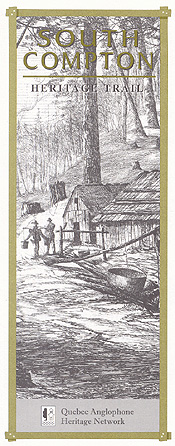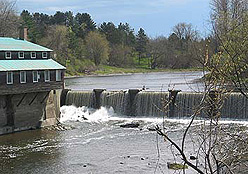
Highland streams part ways on the slopes of the Quebec-New England border. Some flow north toward the St. Lawrence. Others join the Connecticut River on its way to the sea. The height of land in between marks one of the oldest pioneer gateways in the Eastern Townships.
This Heritage Trail leads to historic settlements in the Appalachian foothills drained by the Coaticook, Eaton, Moe’s and Salmon (Ascot) Rivers. Long before the arrival of Europeans, these waterways yielded fish, furs and meat for the Indigenous peoples. They served as paths of trade and war for the Indigenous and colonist alike. Their story binds Quebec and New England to a shared heritage.
As British and French colonies vied for control of North America in the 1600s and 1700s, French-backed war parties used these trails to raid English settlements. New Englanders countered with attacks on Canada. With the fall of New France in 1759, English colonists spread further north along the Connecticut River. In the aftermath of the American Revolution, these routes carried thousands of Loyalists over the border.
British authorities distrusted the new arrivals at first and sought to keep them out. However, a few scattered pioneer families were already living in the region when the first survey rights were granted in 1792. A number of Americans had claimed lots in Ascot Township by 1803.
 By 1854, 60,000 English-speaking settlers lived in the Eastern Townships. Half were Americans. They were later joined by French-Canadians who also sought a livelihood in the forests, fields and burgeoning mill towns of old Compton County.
By 1854, 60,000 English-speaking settlers lived in the Eastern Townships. Half were Americans. They were later joined by French-Canadians who also sought a livelihood in the forests, fields and burgeoning mill towns of old Compton County.
GETTING THERE
Begin your exploration at Huntingville, a short drive from Lennoxville, the region’s major English-speaking hub. From Lennoxville, head 2 km south on Route 143, then east onto Route 147.
HUNTINGVILLE
(Pop. 400)
 The story of this village starts in 1814-15 when William Hunting from Massachusetts built a fieldstone dam on the Salmon (Ascot) River to power his grist and saw mills. Flooding washed away the old dam in 1942. A modern concrete dam built in 1944, today provides hydroelectric power. The hamlet’s New England heritage is remarkably preserved in several older houses and the nearby Universalist Church. Built in 1844 on land donated to the congregation by the Hunting family, the restored church is a fine example of early New England-style meeting houses. It is thought to be the oldest Universalist church in Canada.
The story of this village starts in 1814-15 when William Hunting from Massachusetts built a fieldstone dam on the Salmon (Ascot) River to power his grist and saw mills. Flooding washed away the old dam in 1942. A modern concrete dam built in 1944, today provides hydroelectric power. The hamlet’s New England heritage is remarkably preserved in several older houses and the nearby Universalist Church. Built in 1844 on land donated to the congregation by the Hunting family, the restored church is a fine example of early New England-style meeting houses. It is thought to be the oldest Universalist church in Canada.
MILBY
(Pop. 75)
Founded in the early 1790s by brothers Cornelius and Abraham Hyatt Jr., this hamlet at the junction of the Moe’s and Salmon Rivers grew into a busy farming centre along a major trade and settlement route. The Hyatts were Loyalists from New York State who served in the Loyal Rangers Corp under British General Johnny Burgoyne.
Once called Hyatt’s Settlement and later Wilson’s Mills, the community is home to three historic sites, including a little one-room schoolhouse that has been lovingly restored by local descendants of Townships Loyalists. Visitors will find it just off Rte 147 on McVety Rd across from St. Barnabas Anglican Church (1874).
 The Milby Covered Bridge, built in 1873 by Robert and John Hood, is a provincial historic site. Summer tours of the Little Hyatt One-Room Schoolhouse are offered Wednesday through Sunday from 1 to 7 p.m. or by appointment with Patrimoine-Ascott-Heritage. Tel. (819) 346-6746.
The Milby Covered Bridge, built in 1873 by Robert and John Hood, is a provincial historic site. Summer tours of the Little Hyatt One-Room Schoolhouse are offered Wednesday through Sunday from 1 to 7 p.m. or by appointment with Patrimoine-Ascott-Heritage. Tel. (819) 346-6746.
COMPTON VILLAGE
(Pop. 2,200)
Some of the richest soil in the Eastern Townships lies in the Coaticook River Valley, where villages prospered in step with farming. Area livestock breeders enjoyed international acclaim in the 19th century and to this day Compton dairy herds rank among the best in the country.
 Louis St-Laurent, Canada’s 12th prime minister (1948-1957), was born and raised in this village. His father’s general store and the family house next door are preserved as a national historic site and museum. Compton Ladies School, once known as King’s Hall, is another historic attraction, located on Cochrane Road near St. James Church. Built in 1874 to educate English-speaking Anglican girls, the boarding school ran for nearly a century until 1972. It now operates as a hotel.
Louis St-Laurent, Canada’s 12th prime minister (1948-1957), was born and raised in this village. His father’s general store and the family house next door are preserved as a national historic site and museum. Compton Ladies School, once known as King’s Hall, is another historic attraction, located on Cochrane Road near St. James Church. Built in 1874 to educate English-speaking Anglican girls, the boarding school ran for nearly a century until 1972. It now operates as a hotel.
A short side trip on Moe’s River Rd leads to Moe’s River settlement where a rare water-powered sawmill still stands. From there, Ives Hill Rd climbs past a pioneer cemetery and schoolhouse, offering scenic views of the countryside round historic Martinville, named for early settlers.
Louis S. St-Laurent National Historic Site and Museum
6790 route Louis S. St-Laurent
Telephone: (800) 463-6769 / 835-5448
Website: www.parkscanada.gc.ca
COATICOOK
(Pop. 8,988)
This small textiles city takes its name from the Abenaki phrase Koatekwok, meaning to the pine river. The river has always been the community’s life-blood.
 Today the city operates a park near the gorge, spanned by the world’s longest suspended walkway. There is a tourist centre here where visitors can pick up a guide to 13 local heritage sites.
Today the city operates a park near the gorge, spanned by the world’s longest suspended walkway. There is a tourist centre here where visitors can pick up a guide to 13 local heritage sites.
The city’s founders, the Baldwins, ran sawmills in Coaticook as early as 1830. Lewis Sleeper later built a clothespin factory near the gorge. His brother, Wright Sleeper, made farm machinery and his nephew Frank became a famous inventor in New England.
In the 1870s and 1880s, local industrialists built modern wool and cotton mills employing hundreds of French and English workers. The Coaticook Knitting Co. specialized in mass-produced underwear and was later owned by Penman’s, a leading garment firm. The imposing Belding-Corticelli factory on Route 147 was originally called the Cascade Narrow Fabric Co., a division of Coaticook Cotton Co. started by John Thornton.
Coaticook is a French-speaking city today. However, homes and streets in the old quarter still speak of the city’s New England heritage. The Beaulne Museum, housed in a 30-room Victorian mansion known as Château Norton, was inventor Arthur Osmond Norton’s home.
Beaulne Museum: 96 Union Street
Tel.: (819) 849-6560
HEREFORD MOUNTAIN LOOKOUT
Route 141 south of Coaticook traces a stretch of trail settlers knew as the Old Snag Road. Watch for a remodeled farmhouse at the turn-off for St. Herménégilde: in the 1830s it was owned by a notorious counterfeiter named Frizzle.
 At the village of St. Herménégilde, travelers may drive to the top of Hereford Mountain for a panoramic view of the surrounding Appalachian countryside. Land for the lookout was donated in 1998 by Neil Tillotson, a millionaire rubber manufacturer who was born in East Hereford Village and lived to be more than 100 years old.
At the village of St. Herménégilde, travelers may drive to the top of Hereford Mountain for a panoramic view of the surrounding Appalachian countryside. Land for the lookout was donated in 1998 by Neil Tillotson, a millionaire rubber manufacturer who was born in East Hereford Village and lived to be more than 100 years old.
EAST HEREFORD – HALL STREAM
(Pop. 323)
Present-day East Hereford grew up around a sawmill built in 1818 by Joseph Weston. Older settlements existed a few kilometres south of here, along a branch of the Connecticut River called Hall Stream. Today the stream marks the Quebec-New Hampshire border.
After the American Revolution, many New Englanders came to Lower Canada by way of the Hall Stream trail, a portion of which is traced by Rte. 253 today. Two pioneer graveyards lie on Rte. 253 between East Hereford and the U.S. Customs.
 A quirky bit of Quebec history unfolded here during a lingering border dispute. The Treaty of Versailles (1783) that ended the American Revolution fixed the boundary on highlands separating streams that drain to the St. Lawrence from northwestern-most tributaries of the Connecticut. Canada thought the Connecticut headwaters rose in the Connecticut Lakes. New Hampshire drew the border along Hall Stream.
A quirky bit of Quebec history unfolded here during a lingering border dispute. The Treaty of Versailles (1783) that ended the American Revolution fixed the boundary on highlands separating streams that drain to the St. Lawrence from northwestern-most tributaries of the Connecticut. Canada thought the Connecticut headwaters rose in the Connecticut Lakes. New Hampshire drew the border along Hall Stream.
Trouble arose after the War of 1812-14 when settlers moved to the area under rival claims. In 1832, while Canada and the U.S. disputed the border, 120 homesteaders between Hall Stream and Indian Stream set up their own country, called the Republic of Indian Stream. Three years later they joined New Hampshire. Since 1842, the area has been recognized by treaty as U.S. territory.
SAWYERVILLE
(Pop. 836)
The forest that became Sawyerville was first cleared by Massachusetts-born Josiah Sawyer in 1793. A monument to him can be seen at the main village crossroads. Sawyer cut a trail to his future mill site from Missisquoi Bay on Lake Champlain. In 1794 he settled his family on the banks of the Eaton River where he was joined by immigrants from Leamington, Vermont.
Mills were Sawyerville’s driving force for a century. During later settlement years, a number of families from the old county of Argenteuil in the Laurentians came to farm the surrounding countryside. Other families came from Inverness, Leeds and Ireland townships in Megantic County.
 EATON CORNER
EATON CORNER
(Pop. 50)
This stage-coach stopover at the junction of historic Hereford Rd (Rte 253) and the old Bayley Rd (Rte 210) was a busy village in the pre-railway settlement era. Many New England-style buildings from this period survive, including two provincial historic sites. Eaton Corner Academy was founded in 1824 to offer training to rural teachers. The current building dates to 1864 and serves as town hall. The Congregationalist Church across the street dates to 1841 and is now home to the Compton County Historical Museum.
Five heritage sites in the village are marked with plaques, including the William Stone House in which Canada’s first medical operation involving anesthetic (1847) was performed.
Wind up your tour with a stop at the lookout erected on Rte. 210 before returning to Lennoxville by way of Rte. 108.
Compton County Historical Museum
Tel.: (819) 875-5256.
The Heritage Trail series is presented by the Quebec Anglophone Heritage Network, funded jointly by the Department of Canadian Heritage and Economic Development Canada. Space constraints preclude mention of all possible sites. Thanks to Ron Owen, the Compton County Historical Society and Patrimoine Ascott-Heritage. For more information, call the QAHN office at (819) 564-9595 or toll-free within Quebec at 1 (877) 964-0409.![]()
![]()